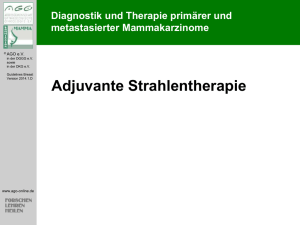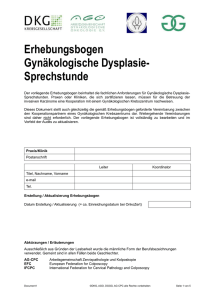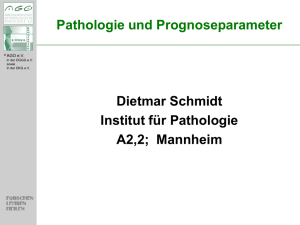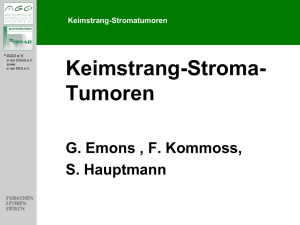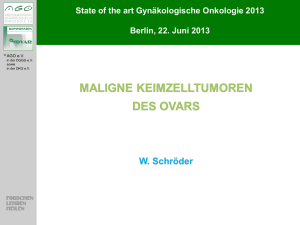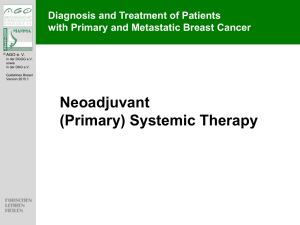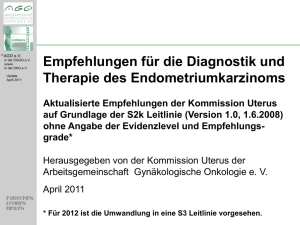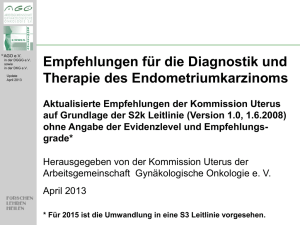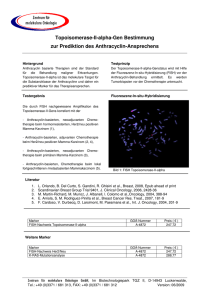ZNS-Metastasen beim Mammakarzinom - AGO
Werbung
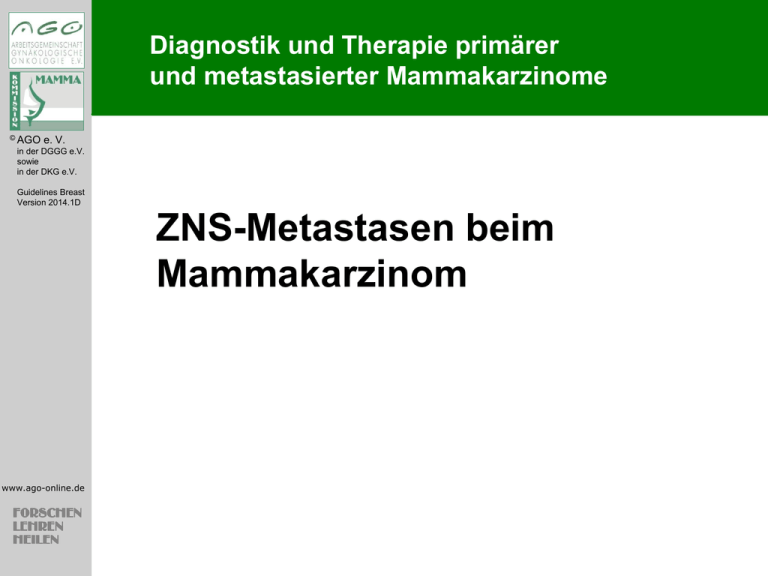
Diagnostik und Therapie primärer und metastasierter Mammakarzinome © AGO e. V. in der DGGG e.V. sowie in der DKG e.V. Guidelines Breast Version 2014.1D ZNS-Metastasen beim Mammakarzinom www.ago-online.de ZNS-Metastasen beim Mammakarzinom © AGO © AGO e.V. e. V. in der DGGG e.V. in der DGGG e.V. sowie sowie in der DKG e.V. in der DKG e.V. Guidelines Breast Guidelines Breast Version 2014.1D Version 2014.1D www.ago-online.de Versionen 2003–2013: Bischoff / Diel / Friedrich / Gerber / Lück / Maass / Nitz / Jackisch / Jonat / Junkermann / Rody / Schütz Version 2014: Maass / Müller ZNS-Metastasen beim Mammakarzinom – Inzidenz © AGO e. V. Das Mammakarzinom ist zweithäufigste Ursache von ZNS-Metastasen In Autopsie-Kollektiven: in der DGGG e.V. sowie in der DKG e.V. Guidelines Breast Version 2014.1D www.ago-online.de Parenchymale ZNS Metastasen: Leptomeningeale ZNS-Metastasen: Stetig steigende Inzidenz (10 % 40 % ) Anstieg der Inzidenz verursacht durch: ~30 - 40 % 5 - 16 % Effektivere Behandlungsoptionen der extrazerebralen Metastasen Vermehrter Einsatz der MR-Diagnostik Datenlage für Behandlung von ZNS-Metastasen des Mammakarzinoms ist unbefriedigend, da Studien meist nicht Mammakarzinom-spezifisch. Teilnahme an der deutschen Registerstudie zu ZNS-Metastasen Mammakarzinom empfohlen. ZNS-Metastasen beim Mammakarzinom – Risikofaktoren © AGO e. V. in der DGGG e.V. sowie in der DKG e.V. Guidelines Breast Version 2014.1D Primärtumor: Negativer Östrogenrezeptor-Status (Basalzell-Typ / triple negativ) Hohes Grading, hohes Ki-67 HER2 und / oder EGFR (HER1) Überexpression Vorbehandlung mit Trastuzumab in der metastasierten Situation ZNS-Metastasen sind häufiger Östrogenrezeptor-neg. und überexprimieren häufiger HER2 und / oder EGFR www.ago-online.de Keine Evidenz für Hirnmetastasen-Screening bei asymptomatischen Patientinnen Graded Prognostic Assessment (GPA) Arbeitsblatt zur Abschätzung des Mortalitätsrisikos bei Hirnmetastasen (BM) © AGO e. V. in der DGGG e.V. sowie in der DKG e.V. Guidelines Breast Version 2014.1D 0 0.5 1 1.5 2 Score KPS 50 60 70-80 90-100 n/a ____ Subtype Basal n/a LumA HER2 LumB ____ Age, years > 60 < 60 n/a n/a n/a ____ Prognostic Factor Sum total ____ Median survival by GPA: GPA 0-1.0 = 3.4 months GPA 1.5-2.0 = 7.7 months GPA 2.5-3.0 = 15.1 months GPA 3.5-4.0 = 25.3 months www.ago-online.de Subtype: Basal: triple negative; LumA: ER/PR positive, HER2 negative; LumB: triple positive; HER2: ER/PR negative, HER2 positive. ECM, extracranial metastases; ER, estrogen receptor; HER2, human epidermal growth factor receptor 2; KPS, Karnofsky performance score; LumA, luminal A; LumB, luminal B; PR, progesterone receptor. Sperduto PW: J Clin Oncol 2012, 30:419-425. Unabhängige Prognosefaktoren bei Hirnmetastasen eines Mammakarzinoms © AGO e. V. in der DGGG e.V. sowie in der DKG e.V. Guidelines Breast Version 2014.1D Multivariate analyses of significant factors associated with survival after WBRT • OS in 1, 2 and 3 years was 33.4 %, 16.7%, and 8.8 % • Median survival time by Recursive partitioning analysis (RPA) class in months: Class I: 11.7, class II: 6.2 and class III: 3.0 VARIABLE P HR <0.0001 4.34 2.5 7.14 SINGLE METASTASES 0.14 1.08 0.97 1.21 KPS >= 70 0.55 1.31 0.55 3.23 BRAIN MET SCORE (BS-BM) 0.58 0.63 0.12 3.29 RPA <0.0001 1.64 1.32 2.04 0.66 0.92 0.63 1.34 <0.0001 2.38 1.63 3.44 SURGICAL RES www.ago-online.de CONTR PRIM TU NO EXCRANIAL MET (95%-confidence interval) Viani GA et al. BMC Cancer 2007, 7:53 Hirnmetastasen (1–3 Läsionen) © AGO e. V. Oxford / AGO in der DGGG e.V. sowie in der DKG e.V. LoE / GR Guidelines Breast Version 2014.1D WBRT + SRS Boost oder Neurochirurgie (vs. WBRT) 2a B ++ Verbessert lokale Kontrolle, aber nicht Überleben SRS (<3 cm) oder Neurochirurgie +/- WBRT* 2b B ++ WBRT** 2b 3b B + B +/- Stereotactic fractionated RT (SFRT) www.ago-online.de * In Einzelfällen kann auf die zusätzliche WBRT verzichtet werden. Zusätzliche WBRT erhöht die lokale Kontrolle und Sypmtomkontrolle, nicht aber das Überleben in allen Kohorten. Eine kombinierte Behandlung wird vor allem bei Patientinnen mit singulären Metastasen und gutem Allgemeinzustand empfohlen. ** Bei Patientinnen mit ungünstiger Prognose und / oder Allgemeinszustand SRS = stereotactic radiosurgery WBRT = whole brain radiotherapy Mögliche Entscheidungsfaktoren Neurochirurgie versus Stereotaktische Radiochirurgie © AGO e. V. in der DGGG e.V. sowie in der DKG e.V. Guidelines Breast Version 2014.1D Factors in favor of neurosurgery: • Histological verification e.g. after a long recurrence-free interval need for immediate decompression, life-threatening symptoms • Tumor size > 3cm not allowing stereotactic radiosurgery • Surgically favorable location Factors in favor of primary radiotherapy: • No need for rapid decompression • No need for histological verification • Tumor location poorly amenable to surgery www.ago-online.de Adjuvant Whole-brain Radiotherapy Versus Observation After Radiosurgery or Surgical Resection of One to Three Cerebral Metastases: Results of the EORTC 22952- 26001 Study © AGO e. V. in der DGGG e.V. sowie in der DKG e.V. 2-year relapse rate after whole-brain radiotherapy (WBRT) versus observation after surgical resection or radiosurgery Guidelines Breast Version 2014.1D www.ago-online.de after surgical resection (n=160) after radiosurgery (n=199) WBRT observation WBRT observation Local recurrence 27% 59% (p<0.001) 19% 31% (p=0.040) New lesions 23% 42% (p=0.008) 33% 48% (p=0.023) •Only 12% of the patients had brain metastases from breast cancer. •Overall survival was similar in the WBRT and observation arms (median, 10.9 vs. 10.7 months, respectively; P = .89). •Intracranial progression caused death in 44% patients in the OBS arm and in 28% patients in the WBRT arm. Kocher M. J Clin Oncol 2011, 29:134-141 Multiple Hirnmetastasen © AGO Oxford / AGO LoE / GR e. V. in der DGGG e.V. sowie in der DKG e.V. Guidelines Breast Version 2014.1D WBRT (supportiv Steroide*) Prolongierte RT ( 1 Woche) Radiochemotherapie 1a 3b 3b A B C ++ ++ +/- Chemotherapie allein 3a D +/- Corticosteroide allein 3a B +/- Chemotherapie allein 3a D +/- Lapatinib +/- Capecitabin (HER2-pos. Fälle) 2b B + Erneute Strahlentherapie (falls möglich) 3a D +/- Bei Radioresistenz / Rezidiv: www.ago-online.de *symptomadaptiert Mögliche Behandlungsstrategie für Hirnmetastasen eines Mammakarzinoms © AGO e. V. in der DGGG e.V. sowie in der DKG e.V. Guidelines Breast Version 2014.1D 1-3 Hirnmetastasen (BM) Guter Allgemeinzustand und Prognose (KPS>70) Neurochirugie oder SRS + WBRT* www.ago-online.de Multiple BM Schlechter Allgeleinzustand und Prognose (KPS<70) WBRT oder SRS WBRT * In Einzelfällen kann auf die zusätzliche WBRT verzichtet werden. Zusätzliche WBRT erhöht die lokale Kontrolle und Symptomkontrolle, nicht aber das Überleben in allen Kohorten. Ein agressiverer Behandlungsansatz wird vor allem bei Patientinnen mit gutem Allgemeinzustand, singulären Metastasen und guter Prognose empfohlen. SRS = stereotactic radiosurgery WBRT = whole brain radiotherapy Systemische und symptomatische Therapie von Hirnmetastasen © AGO Oxford / AGO LoE / GR e. V. in der DGGG e.V. sowie in der DKG e.V. Guidelines Breast Version 2014.1D Fortsetzung der anti-HER2-Therapie im Falle einer extrakranialen Remission 2c C + Lapatinib + Capecitabin als initiale Behandlung (HER2 positiv) 1b B +/- Chemotherapie als alleinige Primärbehandlung 3 D - Routinemäßiger Einsatz von Antikonvulsiva 3 C - Glucocorticoide (nur wenn Symptome und / oder 3 C ++ Verdrängungseffekt) www.ago-online.de LANDSCAPE: An FNCLCC Phase II Study with Lapatinib (L) and Capetitabine (C) in Patients with Brain Metastases (BM) from HER2-positive (+) Metastatic Breast Cancer (MBC) before Whole-brain Radiotherapy (WBRT) © AGO e. V. in der DGGG e.V. sowie in der DKG e.V. Guidelines Breast Version 2014.1D Nr. of eligible patients N=45 CNS- ORR 67% Median TTP 5.5 Mo. Median time to WBRT 8.3 Mo. www.ago-online.de Bachelot T, Lancet Oncology 2013, 14:64-71 Leptomeningeosis carcinomatosa Lokale Therapie © AGO e. V. in der DGGG e.V. sowie in der DKG e.V. Guidelines Breast Version 2014.1D Intrathekale oder intraventrikuläre Therapie MTX 10-15 mg 2-3x/ Woche (+/- Folsäure-Rescue) Oxford / AGO LoE / GR 2b B ++ Liposomales Cytarabin 50 mg, q 2w 3b C ++ Thiothepa 3b C + Steroide 4 D +/- Trastuzumab 4 C +/- Radiotherapie www.ago-online.de Fokal (bei größerem Tumorvolumen) 4 D + WBRT 4 D + Neuroaxe (disseminierte spinale Herde ) 4 D +/- Aufgrund der schlechten Prognose einer Leptomeningeosis carcinomatosa sollte auch rein symptomatische Therapie erwogen werden, insbesondere bei Patientinnen mit schlechtem Allgemeinzustand

